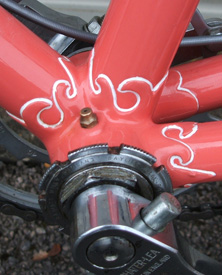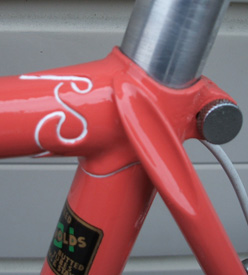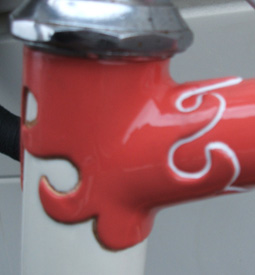Vol. 2, Issue 45 – March / April 2013
Posted: Thursday 14th March 2013
The Tweed Run 2013 was held on Saturday 13th April and started in the quadrangle of University College London which was an ideal place to meet, especially for us as UCL is a few minutes bike ride from King’s Cross railway station.
As usual we got there very early as the milling around and socialising at the start and lunchtime are a great part of the day. We soon met many people we knew both from the UK and abroad and spent a lot of time chatting and exchanging bike details. The Tweed Run must amass one of the most eclectic mixes of bikes in the UK. Some 500 entries are accepted each year and the variety has to be seen to be believed. Naturally we took lightweights: Patricia rode her 1948 Hobbs Superbe (image below) as rain was threatened so she opted for mudguards. She was wearing a rather nice tweed jacket which would not have been improved by a streak of mud up the back!
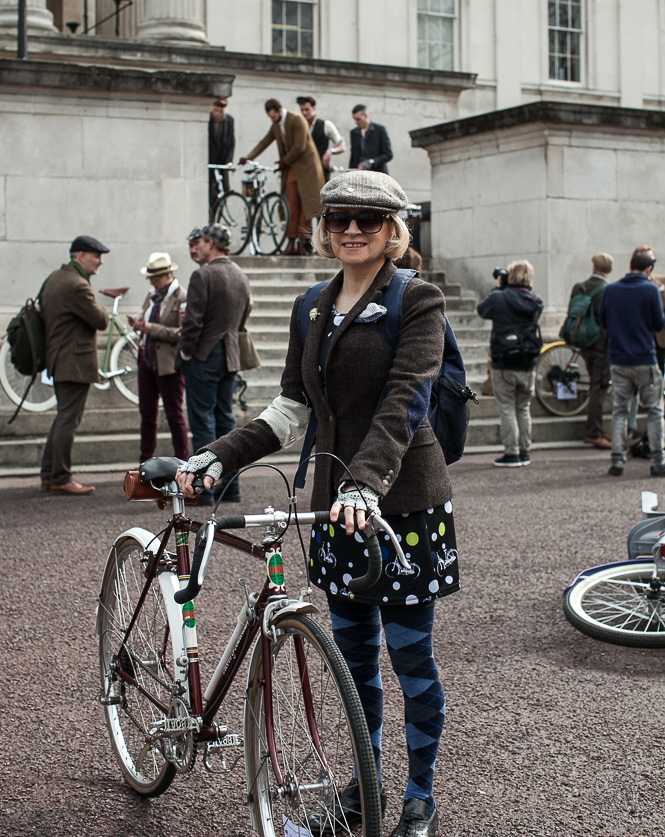
I risked getting wet and took my 1976 Mercian Super Vigorelli track but decided not to fit the wood sprints as I prefer they keep dry. The Mercian did display some of the new Drillium features with chainring and brake stirrup suitably treated. Needless to say this did not go unnoticed and there must be photographs of them around the world, especially in Japan.
Lightweights are in a minority at the Tweed Run as it is a meeting place for many of the new ‘urban cycling scene’ and many variations of this were on show. Some companies have created a niche for themselves by supplying custom-built town machines of many shapes and sizes such as Tokyo Bikes of London. A unifying item is often the large basket on the front which is especially popular amongst women owners – it would be bordering on sexism to discuss this further, especially as I have a basket on the front of my ‘shopper’.
The Tweed Run is also a show piece for various cargo bikes and this is home from home for us as their use is widespread in Cambridge. Very popular is the Workcycle which comes in many forms. The most widely used on the Cambridge school run has a wooden box with room for up to three children. They also come in various configurations for cargo transport.
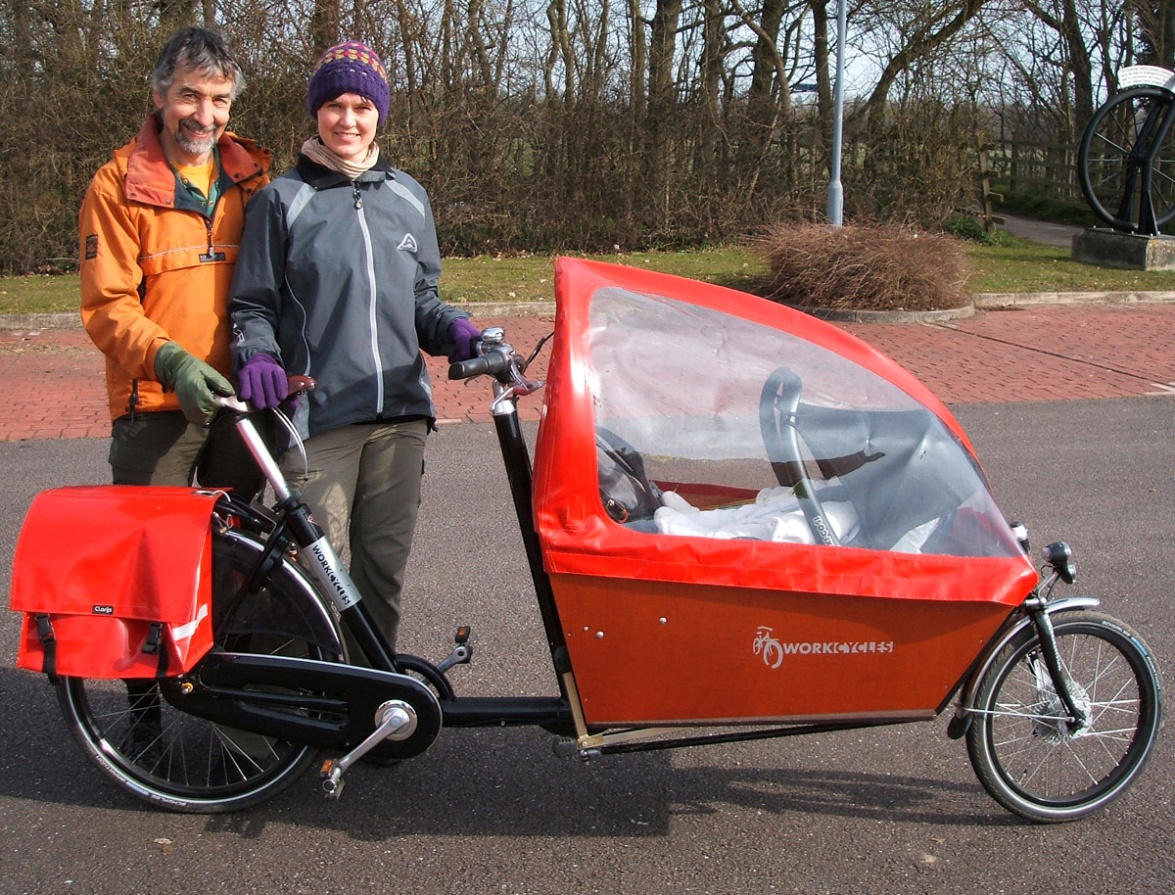
One of the joys of the Tweed Run is to be part of a crowd of 500 on bikes, all happy and mostly smiling. A huge contrast to street life in general where stress seems to rule the day. Mick Madgett commented on my mention of grease ‘pulling away’ from bearings in bottom brackets, etc: (Lightweight News 44)
“Your mention of the grease not being in the bracket bearings reminds me of an anecdote from my father about a Diss club rider in the 1950’s, who insisted on pumping grease into his bottom bracket via his ‘Tecalmit’ nipple on a weekly basis, despite Dad’s advice that it was ‘OTT’ to use modern parlance.
One day his bike came into the shop for some work, and dad picked it up by the saddle to put it on the stand, and found his fingers covered in grease, which was coming out of the top of his seatpin!
After removing the bottom bracket, as the axle could hardly be turned when the cranks were removed, about 2lb of grease was melted out of the various frame tubes. Again, the only place ‘grease-free’ was the bearing tracks!”
Mick also went on to mention the cycling club huts at Ugley:
I think you’ll find that the Lea Valley club actually ‘took over’ the Comet hut at Burton End when they were formed from the Comet ‘remnants’ in the late ’50’s, rather than having one of their own.
Collection Development Policy (With apologies to Patricia who does this sort of thing as part of her day job). A light-hearted look at collectors and collections. When you think about it, all collections start with one bike (or other artefact!). The male dictate genes that this is never quite enough and he will soon add to it and so a collection is started. I guess the number of male collectors outnumber female by at least ten to one and that figure is far exceeded in the classic cycle world.
In my own case, some years ago I visited a friend I had not seen for about forty years and he showed me an Ephgrave frame which he had owned since new, and which he had just restored with the intention of rebuilding it. I fell in love with it, so when, by coincidence, I was at a cycle jumble a month or so later and was offered a very similar Ephgrave frame, I snapped it up. The rest is history.
As I did a lot of cycling when a lad in the fifties, our collection was initially based around this era plus one or two from 1960s and 1970s. As well as the collection of Classics we also have several modern bikes (including carbon and titanium) but that is another matter for which some will think I should be bound by my own carbon strands to a titanium post and left for the ants to devour!
Many collectors I know say that they now own the dream bikes they could never afford as a youth and equipped with the components they could only aspire to at the time, but others are able to restore their own older bikes – if they were lucky enough to keep them over the years, or replicas of them carefully tracked down to recreate the dream.
In retrospect, if I were starting now, I think I would have done things differently by restricting the number of early classics to half-a-dozen each for myself and Patricia, then also have a few, probably including some Italian classics, from a later period. The Colnago Master Olympic of any age comes to mind – this is such a classic in its own way that Colnago still, to this day, produce an updated version of it. The Campagnolo Delta brake also comes to mind. It was not easy to set up and probably not the best stopper either, but it is, and always will be, a classic icon which seems as synonymous with Colnago as is the Campag Paris/Roubaix gear with Bianchi.
I do have one Italian beauty, a late 50s Cinelli Corsa (I gave up waiting for a Super Corsa) and I would like a later version of it – fitted with modern period equipment so as to have all the delights of modern gears and brakes on this classic frame. The Super Corsa is another classic still going to this day and an example of the influence of retro chic bringing about a revival of these, mainly steel bikes, by many manufacturers who obviously find the exercise financially worthwhile as they always have a prominent position on their stands at cycle shows and the like. There are people who see collecting these steel classics as a fashion statement and they tend to have a money-no-object approach to it. See the Rapha retro style shoes which are a snip at £300 so why not have a polka-dot silk scarf to go with them for £50!
At a social event related to cycling I met someone who had every possible part of his bike gold-plated. We discussed his next project which was to have a ‘new’ Hetchins built and everything on it copper-plated, a far stretch from scruffy urchins in the fifties with their noses pressed against cycle shop windows (cycle-collecting history cliché No. 2!). A few collectors like to make a great virtue of the fact that they only collect bikes in original condition and with all the original paintwork, decals, etc. This is a very fine policy as it stands but if the only collectors of classics were in this category they would be quite a lonely handful of people as such machines are very few and far between. I guess this is the attraction for some. This genre of collectors can easily be identified as they include the word “patina” in every other sentence.
Like several other collectors, many of my own machines were in a very sorry state when acquired, a good example of which being the latest restoration that I heard about just before Christmas. It was an R O Harrison – a make I have a soft spot for – and when I picked it up I realised that it would soon have gone the way of many old classics. Already it had been “rattle-canned” and fitted with a collection of the worst components it is possible to gather in one place. When I got it home I stripped the frame and most of the rubbish fitted to it went straight into the dustbin. I did manage to find a home for the wheels on my town/shopper bike, a Falcon Black Knight, I think
The R O H frame was soon taken to Mario Vaz for a re-spray. I had decided on Salmon Pink with a white head tube – I wasn’t quite sure what it would look like, but on collecting it I was delighted and started to build it up as soon as I got it home. Although not an original I feel pleased to have saved such a classic from a fate worse than death. It turned out to be a very rare example and possibly one of R O H’s top models. It is listed in Readers’ Bikes on the website and examples of the lugwork are shown above.
Some collectors are unable to say no to anything offered to them and they end up with sheds full of nondescript bikes in various states of disrepair. Having gathered them they usually sit in the shed at the bottom of the garden until the collector either dies or is unable to look after them and it is up to the family to dispose of them, either to a rubbish tip or, if they are philanthropic enough, to a charity such as Emmaus.
I sometimes come across yet another type of collector who loves to tell anyone within earshot just how many bikes he has, sometimes upwards of a hundred. For some unfathomable reason they are usually riding the most scruffy nondescript machine in the present company. I was discussing this phenomenon with a friend and he instantly guessed who I was talking about and explained that all of his bikes looked like this and so I wonder what his collection policy was.
It is obvious I think that collecting is a minefield and few of us get across it without a few explosions on the way. The one sure fact is that it is easier to acquire than to dispose of for various reasons, not least because we tend to form sentimental attachments to what we have and most of us would make awful businessmen!
Keith Tubby – Norwich Amateur Bicycle Club tells us the following story:
August Bank Holiday 1953 -Leiston (Suffolk) Grass Track Meeting and Sports Day
With Billy Rix (1930-2005) NABC, my close friend and racing companion, winner of several 100, 50 and 25- mile Time Trials and a grass track competitor, we decided to compete in the Leiston Bank Holiday sports.
Billy was of an ideal build for fast sprinting being of medium height, but extremely muscular and rode a Gillott 22½” track machine – an exact replica of my Gillott of which you have several images in the photo section of the website.
He entered the one mile, five mile and Devil-take-the-Hindmost events and won them all by some distance. In those days, event organisers pestered local shops and stores for event prizes. Billy received, a large silver trophy, an ornate and very large Indian Brass Candelabra and last, but not least, a high backed wooden armed Parker-Knoll armchair.
We tied the candelabra and silver cup round our necks and each hooked one arm through the chair arms and set off for home, some 25 miles away. The journey was not without abuse from irate motorists, as we virtually blocked one side of the mainly narrow roads in this area. It was necessary to change arms every five miles, or so, but we eventually reached the outskirts of Norwich unscathed.
Unfortunately we had to ride straight through the City centre, as Billy lived on Drayton Road which was on the opposite side of the City from our route on the Lowestoft road, but we managed to avoid problems until we rode down Westlegate towards the crossroads at St Stephens. At the bottom of the hill, in the centre of the road, stood a police constable on a raised wooden platform from which he was directing traffic. He took one look at us, bearing down on him with our rather large load and leapt off his platform and ducked down behind it.
As you no doubt realise, we had no brakes as we were on track bikes, so all we could do was heave the wretched chair as high as possible, and ride either side of him without decapitating the unfortunate guardian of the law. As we ploughed our way through scattered pedestrians, many offering advice as to where we should put the offending article of furniture, we heard his outraged bellows. Eventually, we reached Billy’s home and placed the chair in pride of place in the sitting room, where his dear Mother decided “it was just what she wanted”
Our arms were six inches longer than when we left Leiston!!
There is a sad sequel to this tale of youthful stupidity. Billy had just acquired an Alsatian puppy, which Mrs Rix unfortunately left in the house when going shopping. The outcome was inevitable. The dog sat on the chair and ripped the fabric to pieces and totally destroyed the result of our Herculean efforts. Never mind, we are only young once. Luckily !!
Book Review – Steve Griffith
Steve Griffith (author of the piece below) has recently had a book published by the John Pinkerton Memorial Publishing Fund (V-CC): Lightweight Cycle Components Vol. 1
It covers the history of, and catalogues for, Atom, Bayliss Wiley, Bluemels, Brooks, Carradice, CLB, Harden, Lucifer, Lyotard, Normandy, Mafac, Maillard, Resilion, TA, Toeclips, Weinmann, Williams plus a component dating guide. All this and I gather there is more to come as the title contains the words Volume 1. The catalogues are reprinted from the archives of the National Cycle Library/Veteran-Cycle Club Catalogue Library – always a good point of reference as Ray Miller is constantly digitising more and more of the vast catalogue stock held by the V-CC.
Reading this edition will increase your knowledge of many classic components as well as items not usually covered in this sort of publication such as lighting, mudguards and touring equipment. For those who don’t know Steve he doesn’t spend all of his time on gentle V-CC type rides but is often found in the wild parts of Wales and other rugged areas riding with the Rough Stuff Fellowship, of which he is chairman.
F W Evans
Some notes by Steve Griffith on this important marque that began in the early 1920’s
1. Resources
www.bikebrothers.co.uk has an excellent Evans page with links to catalogues, adverts and a dozen or so machines over a wide time frame
Lightweights Catalogue Vol. 3 JPMPF has a section on Evans written by Mike Deering with a guide to dating and a 30s catalogue reprint
www.classiclightweights.co.uk has a brief history by Hilary Stone plus images of some machines
VCC online library has scans of transfers and pre-war catalogues
My Vernon Blake book published by the JPMPF in 2012 has a section on the pioneering role Evans played in fitting derailleur gears in the UK in the late 20’s, the first major shop to do so.
2. Dating
Numbers are sequential until the mid 50’s found on the left of the seat lug. Dates confirmed by bill of sale:
2248 13 May1929 in London Transport Museum
6117 8 October1946 supported by a Bill of Sale
7647 same owner as 6117 August 1951
Later series
3071 1981
F37236 Bob Jackson built 1/15 /1995
Other dates that seem right :
2488 1933 supplied by VCC member
4011 1936 ditto
4107 1936/7 see N and V 350 also has Williams ring with date code for 1937
In Lightweight Catalogues Vol 3 ( has an early 30’s catalogue) following dates are provided:
1714 1929 no earlier probably 1927
5202 1942 probably OK
7005 1946/2 would be 1948 based on above
On Bike Bros page:
1719 1929 No, see above must be earlier 1927
4491 1937 OK
5192 1947 probably 1942
Other frame numbers known
5307 – mine – oval tubes 1942
Pre-war Evans built about 240 frames a year, fewer during the war (still quite few) and post war about 300 until 1951.
So clearly some inconsistencies which require further research
Post mid 50’s differing numbering systems with no confirmed dates. I have a machine built in the late 70’s (based on the Campag Porta ends) no. 249 (on steerer) Nervex lugs but built in 50’s style e.g. mudguard eyes half way along fork/seat stays.
References
CTC Gazette Sept 1938 Article by Hodites (Neville Whall CTC tour leader) on his 8-speed Evans p313 and illustration 307. With Cyclo 44/28 and 14-28 block : Conloys 26 x 1 3/8, Binda bars, Resilions , Brooks B18
CTC Gazette June 1942 letter by FW Evans after A W Rumney’s death about how his was the first derailleur machine he fitted
CTC Gazette July 1942 letter by FW Evans about travelling down the Towy on a Tandem
CTC Gazette March 1943 letter about Evans fitting Cyclo gears 46- 26 and 16, 18 22
CTC Gazette Jan 1945 F W Evans obit. p2
CTC Gazette Feb 1945 details of the new owner p20
Advertised extensively in the CTC Gazette and Cycletouring 20’s to 80’s
3. Special features
1930s catalogues feature a nine page account of the Evans approach and philosophy of frame building. Much is made of their universal jig which enables very accurate sizing and building of any frame. The benefits of tapered lugs are explained (stronger than plain lugs) and the emphasis is on use of best material and building practice. Recommendations for different components are made and stressing the importance of brazed-on fittings e.g. for racks and mudguards and the fact they were the first to build derailleur equipped bikes in addition to those built for Rumney and Hodites also Kuklos (pen name of cycling writer Fitzroy Wray )
Evans claimed their drop out enabled a 12 second wheel change, 23 sec blindfold and 58 secs one hand tied behind the back !
double bottom bracket oilers
double oilers to headsets ( oilers feature direct lubrication to bearings)
– patent rear drop outs which won the CTC improvement plaque 1925 ( patent no 237085) ,see The Boneshaker no.89 Summer 2012 article by Steve Griffith Ref CTC Gazette: April 1925 p100 & June 1926 p189 award ceremony
– cyclometer braze-on on fork blade
– custom rear racks
– own design handlebar, the Shirley 18” wide, 2” drop
ovalised tubes 30s model Luxlyt
early pioneers of fitting derailleur’s in the UK ref A W Rumney : 50 years a Cyclist
All machines supplied in the 30s with Bluemels 15” pump, tool kit, oil can, bag
Some models pre war has a letter code for different gears:
X fixed or free
S Sturmey 3 speed
C Derailleur
E.g. Beam X Beam model with a fixed or free single gear
Advertising strapline F W Evans : the cycle engineers
4. Later history
Features on the cover in Richards Bicycle Book 1975
In 1978 Adventure Cycling by Tim Hughes head transfer shown on p20 ( new style) & p54 (old style)
Moved to 77-79 The Cut, Waterloo from 44 to 46 Kennington Road January 1978 (source advertisements in the CTC magazine)
Frames built in the 90s by Bob Jackson and Roberts of Croydon
-END-
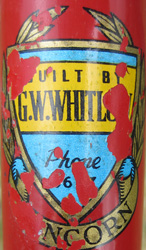
Bill Ives:- I have a frame and forks by G W Whitlow of Runcorn about whom I know virtually nothing.
The frame is a nice quality lightweight with a mid-fifties look about it. Can anybody out there in the internet land add anything at all to my store of knowledge?
With regard to huts on the 32 ms Courses, I have always enjoyed riding events on them. I rode on them from my first season in the Bromley Road Club in 1964 through to the end of the 80s perhaps only one or two each year but events to be enjoyed. My second club, the South Eastern Road Club, used to hold an inter-club 50 with the Eagle RC and we used their Hut as the HQ and used to have a BBQ outside after the event. I hadn’t ridden there for quite a few years. Last year we took the caravan down to a campsite near Ugley and we spent the evening before the Lea Valley 25/TA (Tricycle Association) East trike event with some of their members at their old hut, actually they have two there. A great evening. The event in the morning was right up to my expectations. Very cold, slightly misty, and the course almost completely as it was in the pre-60s era. Magic.
As a member of the Fellowship Cycling Old Timers I went on a short break to Skegness with them a couple of years ago (their annual reunion do). We took the tandem trike and one of the ladies admired it so I asked if she would like a short ride on it. She really enjoyed it. Afterward we got talking. Her name was Pat Seeger and she was in the Rosslyn Ladies team that won the team award in the 1950 women’s 100 mile championship also being the fastest member of that team. Eileen Sheridan was in Coventry CC at that time and won the championship. Pat lives near to that area (Ugley) and we talked about the club huts and courses. I hope this is of interest.
Posted: Thursday 14th March 2013
This article appears in the following categories.
Upcoming Events
Whether you are looking for a gentle social meet up, or a 100-mile ride browse the community’s upcoming events and plan your next weekend outing.

